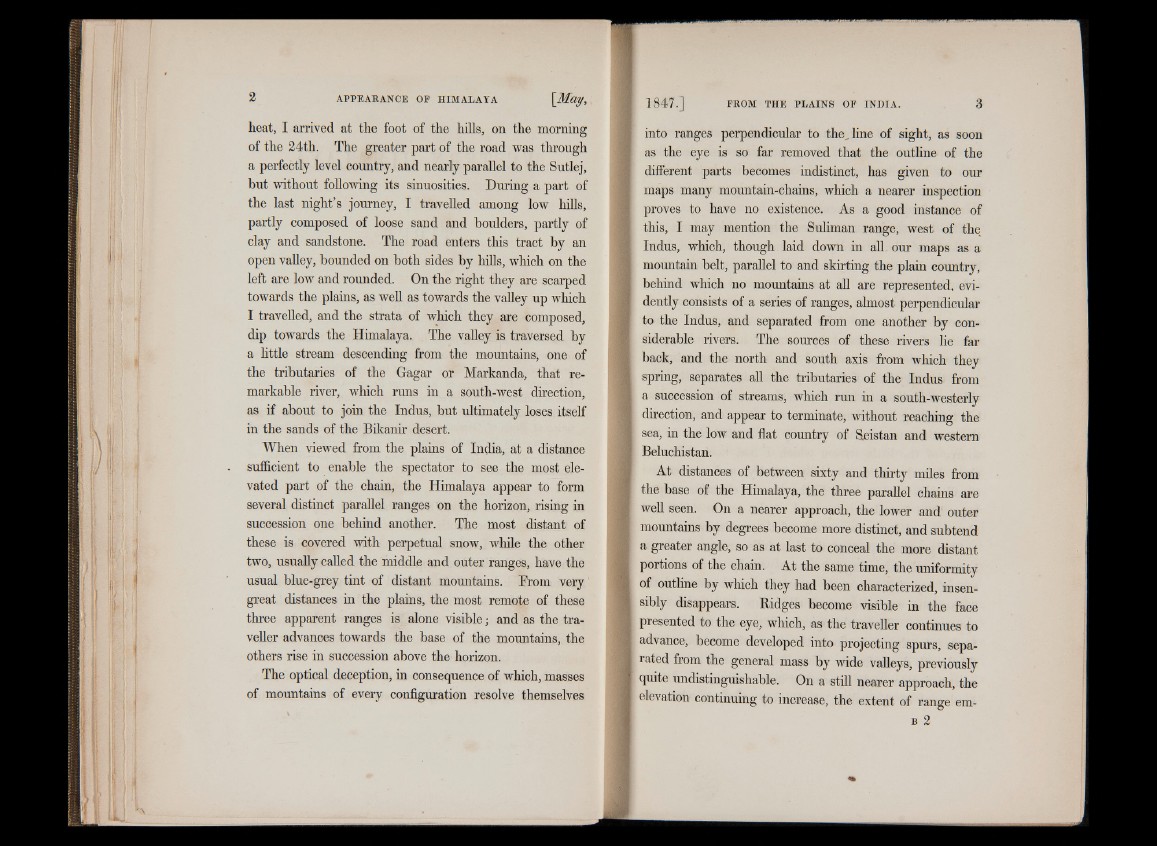
heat, I arrived at the foot of the hills, on the morning
of the 24th. The greater part of the road was through
a perfectly level country, and nearly parallel to the Sutlej,
hut without following its sinuosities. During a part of
the last night’s journey, I travelled among low hills,
partly composed of loose sand and boulders, partly of
clay and sandstone. The road enters this tract by an
open valley, bounded on both sides by hills, which on the
left are low and rounded. On the right they are scarped
towards the plains, as well as towards the valley up which
I travelled, and the strata of which they are composed,
dip towards the Himalaya. The valley is traversed by
a little stream descending from the mountains, one of
the tributaries of the Gagar or Markanda, that remarkable
river, which runs in a south-west direction,
as if about to join the Indus, but ultimately loses itself
in the sands of the Bikanir desert.
When viewed from the plains of India, at a distance
sufficient to enable the spectator to see the most elevated
part of the chain, the Himalaya appear to form
several distinct parallel ranges on the horizon, rising in
succession one behind another. The most distant of
these is covered with perpetual snow, while the other
two, usually called the middle and outer ranges, have the
usual blue-grey tint of distant mountains. From very
great distances in the plains, the most remote of these
three apparent ranges is alone visible § and as the traveller
advances towards the base of the mountains, the
others rise in succession above the horizon.
The optical deception, in consequence of which, masses
of mountains of every configuration resolve themselves
into ranges perpendicular to the, line of sight, as soon
as the eye is so far removed that the outline of the
different parts becomes indistinct, has given to our
maps many mountain-chains, which a nearer inspection
proves to have no existence. As a good instance of
this, I may mention the Suliman range, west of the
Indus, which, though laid down in all our maps as a
mountain belt, parallel to and skirting the plain country,
behind which no mountains at all are represented, evidently
consists of a series of ranges, almost perpendicular
to the Indus, and separated from one another by considerable
rivers. The sources of these rivers He far
back, and the north and south axis from which they
spring, separates all the tributaries of the Indus from
a succession of streams, which run in a south-westerly
direction, and appear to terminate, without reaching the
sea, in the low and flat country of Seistan and western
Beluchistan.
At distances of between sixty and thirty miles from
the base of the Himalaya, the three parallel chains are
well seen. On a nearer approach, the lower and outer
mountains by degrees become more distinct, and subtend
a greater angle, so as at last to conceal the more distant
portions of the chain. At the same time, the uniformity
of outline by which they had been characterized, insensibly
disappears. Ridges become visible in the face
presented to the eye, which, as the traveller continues to
advance, become developed into projecting spurs, separated
from the general mass by wide valleys, previously
quite undistinguishable. On a still nearer approach, the
elevation continuing to increase, the extent of range emb
2